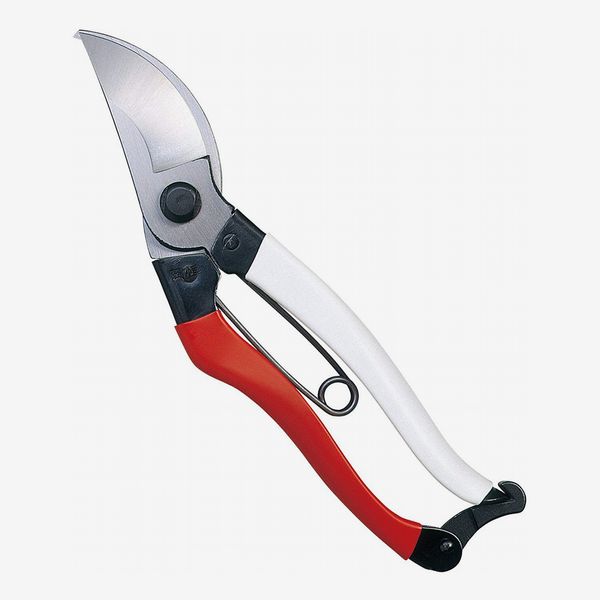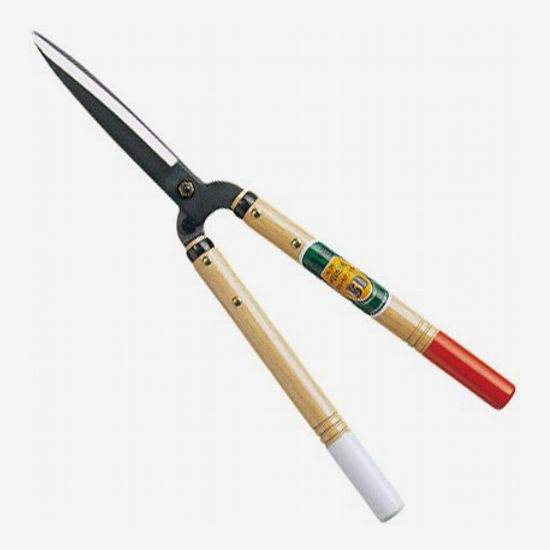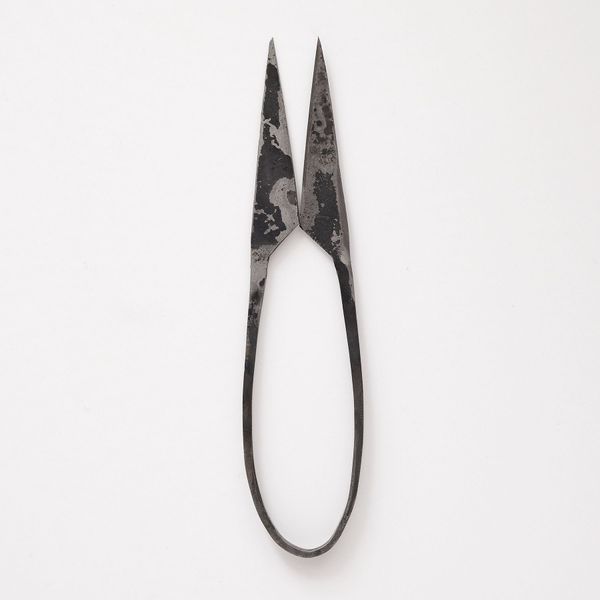
In this article
A sharp pair of shears are of the most indispensable gardening tools, useful for everything from trimming shrubbery to harvesting a crop of tomatoes to removing the dead tops of flowers (known as “deadheading”). Like many other gardening products, you don’t have to break the bank for a quality tool — you can get the same shears professional horticulturalists use for about the cost of a baby rubber tree, and with some maintenance, they’ll last for decades. A tool that consistently delivers sharp, clean cuts is a worthwhile investment — you’ll get through gardening chores more efficiently and with less frustration, and it’s also healthier for your plants. “The cleaner the cut, the quicker a plant heals,” says Kurt Morrell, the vice-president of landscape operations at the New York Botanical Garden (NYBG). “The quicker a plant heals, the less susceptible it is to disease.” To find the best garden tools for various setups — be it a pruner or hedge trimmer — I spoke with Morell and 9 other garden experts.
Update on September 5, 2024: Replaced the discontinued Felco 200 lopper with the similar 21 model; updated prices and checked stock for all other products.
What we’re looking for
Blade type
The best style of blade will depend on how you’re planning to use your shears. You’ll get the cleanest cut from bypass blades, which cut past each other, versus anvil blades, which meet when you cut and tend to crush plant matter. The shape and size of the blades themselves also vary by use. Longer, heavier blades are better for covering a large area; thin, sharp-tipped blades are good for detail and for pruning more delicate plants.
Handles
You want a pair of shears that are comfortable enough to stand up to a long day of repetitive movements. We’re looking for easy-to-grip handles that won’t slip when wet or cause cramps or blisters. For one-handed shears, we’re also noting where a left-handed option is available; like scissors, one handed-shears usually default to right-handed. (Two-handed tools, such as hedge trimmers or loppers, work for both righties and lefties.)
Locking mechanism
A lock keeps a pair of spring-loaded shears shut when they’re not in use, so a reliable, easy-to-use style is important — a fiddly, unreliable lock can cause the blades to either accidentally seize up while you work or spring open inside your bag. Some common styles are latch, dial, and squeeze locks. While we’ve noted locking mechanisms that our experts particularly like, which you choose is largely a matter of personal preference — what matters most is reliable engineering.
Durability and maintenance
Shears aren’t a tool you can treat preciously. They’ll get dirty and wet and thrown into a gardening bag; the blades will cut through tough, woody stems and get covered in sap. A good pair can last for decades, but they require maintenance. Beyond sharpening your blades, you may have to occasionally perform small repairs or replace components. We’re favoring shears made of durable materials that are also designed to make swapping out new parts relatively easy.
Best pruner overall
Blade: Bypass | Handles: Ergonomic rubber-coated | Locking mechanism: Dial | Maintenance: Replacement parts available
Far and away, the most popular pair of all-purpose shears among experts are the F2 bypass pruners manufactured by Swiss company Felco. “A good gardener or horticulturist anywhere in the world is most likely going to have a pair of Felcos,” says Morrell. Felco pruners are popular for their durability and the very long lifespan you can expect from them (Morrell still has his original pair from 1985) and their versatility. NYBG’s School of Professional Horticulture gives a pair of F2s to every new student. There are less expensive pruners on the market, but the years of use you can expect from Felco F2s makes the investment worthwhile. “They’re a staple of every gardener’s toolbox,” says Rachel Burlington, curator of the International Rose Test Garden. “I never leave home without mine.”
Felco also sells a lefty version of the F2 and other styles, including the compact F6, better for smaller hands (both of which are below). I tested both the F2 and F6, and I’ve been using the F6 consistently for about a year. Although the pruners are a heavier-duty tool than I thought I’d need as an indoor gardener, I found myself reaching for them for everything — having a reliable pair of pruners in your arsenal makes you realize just how many things you can use them for. I’ve pruned dead monstera leaves and trimmed bundles of fresh flowers with quicker and cleaners cut than I’d get with scissors. I’ve also found them very useful for processing produce, from chopping off the fibrous tops of fennel bulbs to breaking down kale stems into compost-bin-friendly pieces.
Another reason Felco pruners are our top pick: The brand sells replacements for every part, neatly identified on a schematic on its website, from tiny screws to fresh blades. So far, I haven’t needed them — I haven’t even noticed any dulling from the blades — but it’s an important factor if you’re hoping to follow in Morrell’s footsteps and get a three-decade lifespan out of your pruners.
Best (less expensive) bypass pruner
Blade: Bypass | Handles: Straight | Locking mechanism: Latch | Maintenance: Replacement parts available
For a less expensive alternative, Morrell, Burlington, and Caleb Leech, horticultural manager of the Met Cloisters, all recommend Corona’s bypass pruners, described by Burlington as a “quality tool.” They have steel bypass blades, a latch lock, and straight handles (unlike the ergonomic shape of the Felco pruners). Replacement parts are available on the Corona website and at the Pruner Warehouse.
Best Japanese-made bypass pruner
Blade: Bypass | Handles: Ergonomic | Locking mechanism: Squeeze | Maintenance: Replacement parts available
ARS is one of several Japanese gardening-tool brands with a devoted following in the States. (It also has a great crocodile-centric logo.) Leech almost exclusively uses Japanese-made tools at the Met Cloisters Museum: “I just love how Japanese hand tools are built,” he says. Bob Fiorello, chief horticulturist at San Francisco Botanical Garden, actually prefers the VS8 hand pruner from ARS to Felco’s pruner, although most of his colleagues use the F2. “They are very good quality stainless steel, they are very easy to clean, and they don’t gum up nearly as much as the Felco,” he says. Laura Mele, a horticulturist at the Arnold Arboretum, also prefers these ARS pruners: She likes the squeeze-lock feature, more streamlined than the Felco dial lock, and says the VS8 pruners lead to less hand fatigue. Replacement parts are available from Growtech, the U.S. agent for ARS products, and can be purchased online here.
Best pruner for flowers
Blade: Bypass | Handles: Ergonomic, PVC coating | Locking mechanism: Dial | Maintenance: Replacement parts available
For some tasks, a lighter-duty pruner works best. “These pruners are on my belt in a little holster practically all day long,” says Marc Hachadourian, the senior curator of orchids at the NYBG. “They are kind of my universal tool.” He prefers the brand’s HP-130DX pruners to Felcos for working with flowers, where a precise, ergonomic tool is often more useful than something heavy-duty. “They’ve got a really nice spring and are very lightweight, so after a day of working you’ll have less wear on your hands than if you used Felcos,” he says. Despite their lighter-weight footprint, they’re “extremely durable,” he says, and the blades stay sharp longer than other pruners.
Best Japanese-made pruner with latch lock
Blade: Bypass | Handles: Ergonomic, vinyl coating | Locking mechanism: Latch lock | Maintenance: Spare parts available
Like ARS, Japanese brand Okatsune has a reputation for making solid, hard-wearing tools. Its bypass pruner also has a torsion spring and a latch lock, a style Leech prefers to dial locks, which he describes as “fiddly.” Mele agrees that these Okatsune pruners are a great investment: “A number of people at the arboretum swear by them,” she says.
Best hedge shears
Blade: Straight | Handles: Curved, wooden | Maintenance: Some replacement parts available
The German-made Berger 4490 shears are the only model used to trim and shape the hedges and bushes on the NYBG’s property. Morrell says his favorite thing about them is the wooden handles. “A lot of homeowners will go for something with rubber handles because they think it’s cushiony, but rubber gets slippery when you sweat,” he says. “The wood is just more comfortable if you’re working all day long.” Morrell also appreciates their durability: “If you go and buy something cheap, it may only last one hedge trimming. If you’re using a tool all day long, you want something that’s durable and that’s going to last. We have pairs that are 15 or 20 years old.” One minor drawback: Some small replacement parts are available on the Berger website, but the company doesn’t sell replacement blades. (If they begin to dull, the blades can be sharpened with a whetstone.)
Best (less-expensive) hedge shears
Blade: Straight | Handles: Straight, wooden | Maintenance: Replacement bolts available
Okatsune, the maker of one of our favorite bypass pruners, also makes these hedge shears. They have steel blades that hold an edge well, according to Leech; similar to the Berger shears above, they have wooden handles instead of rubber, more comfortable for long days of hedge-trimming.
Best electric hedge trimmer
Blade: Saw | Handles: Ergonomic | Maintenance: Replacement batteries available
If you want additional horsepower, the Worx WG252 electric hedge trimmer is a versatile, reliable tool. It’s powerful enough to cut through branches up to five-eighths of an inch thick, and Truini recommends it specifically for its maneuverability: It has a telescoping pole with a 12-foot range, and the rear handle rotates so the trimmer can be used vertically and horizontally. The angle of the blade is adjustable, which allows gardeners to trim “the top, bottom, or sides of the hedges comfortably.”
Best loppers
Blade: Toothed bypass | Handles: Straight, rubber-coated | Maintenance: Replacement parts available
Lopping shears, or loppers, are used to cut larger, woodier growth. “It’s like a big pair of hand pruners that you can use for a large-diameter branch,” says Leech. Morrell and Fiorello both recommend Felco’s loppers, which have a toothed bypass blade. “If you are really training a tree or managing shrubs, you want them to be great cuts,” Fiorello says.
Best scissors
Blade: Straight | Handle: Plastic; designed for right-handed and left-handed use | Maintenance: Replacement parts not available
Leech says his “No. 1 tool” is “bonsai scissors or grape scissors” — pointed-tip scissors with small blades designed for grape cultivation that he uses for detail work and trimming flowers. These Joyce Chen scissors are a favorite among chefs — they’re “small and sharp enough to do fine tasks like cutting herbs, but they are also strong enough to go through fish bones, lobster shells, and chicken backs,” says NoMad chef Mike Reilly — and Strategist writer Emma Wartzman also uses them in her garden. “Their shape and size gives you a lot of control,” she says. She’s used them to prune everything from tomatoes to “smaller herbs like oregano or thyme, when you want to snip a few stems without hacking at the whole plant.”
Best hands-free shears
Blade: Straight | Handles: Ergonomic, plastic | Locking mechanism: Dial | Maintenance: Replacement spring available
These spring-loaded, hands-free pruning shears rest on two fingers to free up both hands while you garden. “They are a time-saver, but also they are so light and small you hardly even know they are there,” says Kyle Forrest Burns, the owner of Nye Ranch.
Some more gardening tools we’ve written about
Our experts
• Rachel Burlington, curator of the International Rose Test Garden
• Kyle Forrest Burns, owner of Nye Ranch
• Bob Fiorello, chief horticulturist at San Francisco Botanical Garden
• Marc Hachadourian, the senior curator of orchids at the New York Botanical Garden
• Caleb Leech, horticultural manager of the Met Cloisters
• Laura Mele, horticulturist at the Arnold Arboretum
• Kurt Morrell, VP of landscape operations at the New York Botanical Garden
• Valerie Strait, garden designer
• Joseph Truini, gardener and Strategist contributor
• Emma Wartzman, Strategist writer
Additional reporting by Liza Corsillo, Alex Ivker, and David Notis
The Strategist is designed to surface the most useful, expert recommendations for things to buy across the vast e-commerce landscape. Some of our latest conquests include the best acne treatments, rolling luggage, pillows for side sleepers, natural anxiety remedies, and bath towels. We update links when possible, but note that deals can expire and all prices are subject to change.























